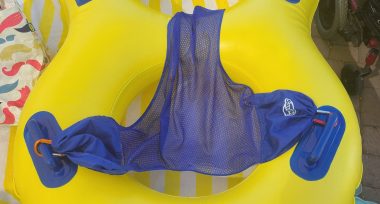With Some Ingenuity, My Daughter Can Relax in the Water

When assessing for developmental delays, doctors and therapists will check a toddler’s protective responses, such as instinctively outstretching the arms to prevent or brace for a fall. I can only imagine the terror of feeling unsteady and knowing there is absolutely nothing to do about a fall.
While my 13-year-old daughter Cammy was going through Rett syndrome regression for a year, starting when she was 6 months old, her protective responses diminished. Between the ages of 6 and 9 months, she could sit independently. But shortly after, if she was gently tapped, she would topple over without attempting to stop the fall.
As she grew older, bigger, and smarter, she understood many more dangers that might be in her way. Still, the world would move in slow motion when I’d see her eyes fill with fear before she’d fall over while I was just out of reach to stop it. She once flipped out of a hammock because she couldn’t control her body enough to stay inside it, nor could she brace for the fall. Luckily, the fall wasn’t far, and she landed on her back.
Cammy requires a vigilant eye 24/7. She always requires complete trust in others to put her in safe situations and protect her.
Cammy is still unable to protect herself or adjust if she is falling over even from a seated position. She can’t use her hands and doesn’t have trunk control to sit up without support.
When we vacation, resorts sometimes won’t allow personal flotation devices in the water. So I must be creative in supporting her when using an inner tube. Without control over her body, if I placed her in a tube, she would slip through the hole. Drowning is a genuine fear of ours. So I found an inexpensive and easy solution to make Cammy feel safe and supported.
I bought a floating pool chair and carabiners on Amazon. They easily fit into my suitcase and don’t take up much room. The carabiners hook into the net openings of the floating chair’s seat. Then, they clip onto the inner tube’s handles.

Making adjustments to an inner tube provides us with peace of mind while our daughter Cammy, who has Rett syndrome, floats in the water. (Photo by Jacqueline Babiarz)
We all want to be able to kick back and relax on vacation. We all deserve the stress-free time spent floating on a lazy river. Now, with a couple adaptations, we can put Cammy’s mind at ease so she can safely lounge in an inner tube without the fear of falling into the water. Watching her float is sometimes the best part of my days on vacation.

Cammy falls asleep in an inner tube while floating on a lazy river in Arizona during spring break. (Photo by Jacqueline Babiarz)
Note: Rett Syndrome News is strictly a news and information website about the disease. It does not provide medical advice, diagnosis, or treatment. This content is not intended to be a substitute for professional medical advice, diagnosis, or treatment. Always seek the advice of your physician or other qualified health provider with any questions you may have regarding a medical condition. Never disregard professional medical advice or delay in seeking it because of something you have read on this website. The opinions expressed in this column are not those of Rett Syndrome News or its parent company, BioNews, and are intended to spark discussion about issues pertaining to Rett syndrome.








Comments